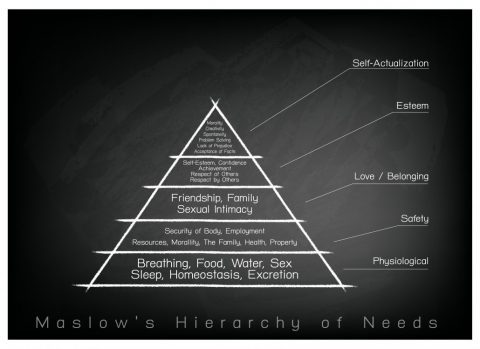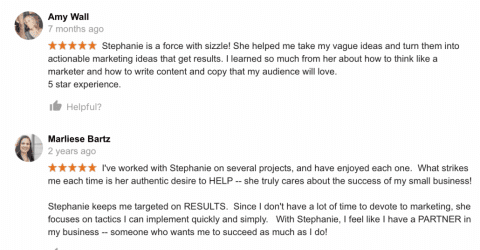It’s downright painful when you pour your heart and soul into developing a product or service, put it out to the world and find no one is interested.
Dr. Seuss knew all about this. After all, he was rejected 27 times before his book, And To Think I Saw It On Mulberry Street was accepted by a publisher. Henry Ford could also commiserate with failure; as prior to revolutionizing the automotive industry with Ford Motor Company, he owned another motor company that went bankrupt. And we can’t forget Sir Richard Branson, the brainchild of Virgin Atlantic and Virgin Music. Before his success story came to be, he started a magazine that failed along with countless other Virgin brands.
In some cases, people refuse to buy certain products/services because they simply aren’t worth buying. But in most cases, people don’t buy what you’re selling for one of five reasons. Let’s explore what they are:
Reason #1: Your message is not resonating with them at an emotional level.
As much as people like to believe they make purchasing decisions based on logic, the truth is, we don’t. In fact, 90% of purchases are made based on emotions. There are 5 emotional motivators that prompt people to pull out their wallet time and time again.
The first one is pride. People buy when they feel like a specific purchase will make them look smarter, faster, richer or better than or at the very least, equal to the people they want to impress in some way, shape or form. Think about why roughly 9,000 people buy Ferrari’s every year–spending as much on a car as they could spend for a house (or ten, depending on the housing market or Ferrari model.) How much does it have to do with status vs. the actual engineering of the car? When you drive a Ferrari, you make a certain statement. And if that statement is important enough to you, chances are, you’ll do whatever it takes to get your hands on the keys to your statement vehicle.
Second, I’m sure you can agree that most people want life to get better in some way. They want to get a better job, make more money, have a happier marriage, reach their goal weight,…. you get the idea. If you can paint a positive mental picture that shows people their lives will be better once they purchase what you sell, you’ll sell a lot more.
If you took Psych 101 in college you probably remember studying Maslow’s hierarchy of needs. It was a theory that revolved around what motivates people to do things.
One of the primary motivators he recognized was the sense of belonging. People are born with an innate desire to belong to something bigger than themselves. Billions of dollars are spent each year by people from all walks of life that buy into something because they believe it will make them belong.
The fourth emotional motivator that I want to address is security. If you revisit Maslow’s theory, you’ll see security is a huge motivator. If a person feels unsafe and you create authentic marketing messages that showcase the benefits of that fear being squashed, prepare to be inundated with business.
Finally, I’d be remiss if I didn’t bring up fear. No one wants to look stupid. No one wants to miss out on something. No one wants to feel unwanted. Fear is perhaps the most powerful motivator. When you show your ideal clients that your product or service will help them obliterate their fears, you’re on the brink of something magnificent.
The first key to getting more people to buy what you sell is to know them. I mean really, really know them. First, you have to have a crystal clear picture of who your ideal client is and you need to understand what motivates them most—is it fear, security, sense of belonging, hope or pride? Then, you need to create your marketing messages around these motivators. Like they say, features tell, benefits sell. When you really understand what makes your ideal clients tick, you will be lightyears beyond most of your competitors because you’ll be able to create those emotional marketing messages that cut straight to the heart. And like I said in the beginning of this post, 90% of purchases are based on emotions. That said, consider this your cue to turn up the emotions and connect with your prospects at the heart level.
Let me give you an example. Budweiser sponsors Super Bowl commercials every year. Here’s a question to think on…what on earth do horses have to do with beer? NOTHING! Absolutely nothing. But you know what the Clydesdale horses represent? Strength. Beauty. Speed. Likely the same things most beer drinkers want to be associated with.
There’s this subconscious connection we make between the horses and the beer. Silly as it sounds, the truth is, people start to think that if they drink the beer, they will also have strength, beauty and speed. They don’t even know they’re doing it…but they are.
Now, before I move on to sharing the second reason more people aren’t buying what you sell, I want to teach you about something I call mirror language or the secret language of sales. You may have heard about the power of mirroring body language. I think there’s equal power in mirroring speech.
When you mirror speech, you show people that you’re really listening to them. And you get extra credit when you show empathy in the process. Let me give an example of this. When I called T-Mobile a while back about a problem I was having with my phone, they used the speech mirror strategy on me. After I shared the reason for my call with the operator, she said, “Gosh Stephanie, I don’t blame you for feeling frustrated when your phone is making that strange noise. That would be very irritating! I’m going to work with you right now to make sure we can put an end to that, ok?”
Suddenly I felt like I had a friend. A friend that cared about my woes and one that was committed to fixing it. How do you think that made me feel? Do you think I’m more likely to continue doing business with T-Mobile? Maybe to even buy a new phone or refer a friend to them? I sure am. Mirror language is powerful. I told the operator up front that I was frustrated and that the problem was irritating me. She used my language right back on me and, boom – she had me in the palm of her hand.
I’m not going to get into neuro-linguistic programming with you guys today, mostly because this blog would be entirely too long if I did, but if you haven’t learned what NLP is, I encourage you to spend some time on Google so you can get your arms around it. It’s another really powerful persuasion tool.
Now, let’s get back to why more people aren’t buying what you sell.
Reason #2: You’re Giving Up Too Soon.
When it comes to sales, perseverance is everything. Here are some statistics you really need to chew on:
- Only 2% of sales come after the first meeting. TWO percent! If you’re meeting with a prospect once, not getting the “yes” that you’re looking for and then giving up and starting over with someone else, you’re missing a huge opportunity!
- Only 20% of leads are followed up on. 20%! So what happens to the other 80% of your prospects? They’re probably working with your competitors! Ouch! I know that it hurts to hear the truth but I say this to you in love…you have got to get in the business of courting your prospects. If you went on a first date with a guy that asked you to marry him within the first hour of meeting, do you think there’s any chance you’d say, “yes?” Heck no! Why? Because you don’t know him. You don’t trust him. You’re not even sure if you like him! People buy from people they know, like and trust. It takes time to earn that. Be patient.
Now, you might be wondering just how patient you have to be. And when it really is time to give up. Well, that varies, but the most common belief is that you have to “touch” a prospect a minimum of 5 times before you’re going to get a sale. Many resources even say 12x. Research shows 44% of salespeople give up after one “no” and another 22% give up after two “no’s.” Three “no’s” and we lose another 14% and after four “no’s,” an additional 12% fall off the sales wagon. You want to know what the remaining 8% do? Well, it’s more about what they don’t do. They don’t give up. And that’s why they win 80% of the sales.
You need to create a stellar follow-up plan. You can’t wing it anymore. You need to know exactly when you’re going to touch your prospect next, how you’re going to touch them and what you’re going to say when you do.
Reason #3: You lack social proof.
If you’re not familiar with the term, I’ll tell you that social proof is the reason most of us do many of the things we do…and for the most part, we’re not even aware of it.
Did you catch that? Read it again if you need to!
When we see or hear that a lot of other people are doing something, we subconsciously start to believe it would be a good idea if we did it, too. That’s why you see so many marketing messages that sound something like this, “join 29,000 other fans that love to eat breakfast for dinner.” Even if you don’t like to eat breakfast for dinner, when you find out 29,000 other people are doing, doesn’t it make you wonder if you should, too? I mean, if it’s good enough for them, do you think it’s maybe good enough for you? I’ll put my money on yes.
Now, there are a lot of different types of social proof and I’ll let you research that on your own, but I do want to talk today about one form of social proof that I’m a huge believer in—the testimonial.
You must, absolutely must, make securing testimonials a critical part of your marketing strategy. The truth is, you can talk all day about how great you are but if you’re the only one tooting your own horn, it’s not going to get you very far.
I recommend that my clients get in the habit of asking for a testimonial from clients just as soon as they tell you they’re happy. You know those lovely emails you get that make your day? And the voicemails you get from clients telling you how pleased they are? As soon as you get something like that, no matter how simple or casual it may be at first, when you acknowledge the kind remarks, ask them right then and there if they’ll put it in writing.
Posting testimonials on your website is great BUT I think it’s even more powerful to get testimonials off of your site…because that way, people know you didn’t mess with them. LinkedIn makes it super simple for someone to post a recommendation for you. And this is what it look like when people post reviews for you on Google:
To make writing reviews online easy for my clients, I have a form that I often send to help them get it done. It has step-by-step instructions and links so they can easily share their recommendation on the site of their choice. Often, I’ll just tell them how much I appreciated what they told me, and I’ll ask them to put it in written form. As soon as people learn they’re not going to have to sit down and write a lengthy and overwhelming recommendation letter, they jump on board fast. It also helps when I tell them 1-2 sentences will suffice. In addition, I tell people to skip the fancy corporate lingo and to simply share from their heart. Altogether, this minimizes the amount of work the referrer has to put into this and makes it far more likely that they’ll do it for you.
I have reviews in multiple places online and you should, too. If you want to see how more of my reviews look, visit my LinkedIn page (and hey, let’s connect there while you’re at it). Search SizzleForce Marketing on Google and 9 glowing reviews will show up. You can even find a few on Facebook. Then if you visit the testimonials page on my website, you’ll see some familiar content along with some testimonials that were never transferred to the review sites, but one of these days I’ll get around to making that happen. 🙂 I also invite you to look at the speaking page on my website so you can see how I use social proof there to secure new speaking engagements. Acquiring these speaking reviews was simple: one day I asked my Facebook community to post their comments if they had ever heard me speak at an event. What you see posted on the speaking page are the wonderful responses I got. As you’ll see, I just took a screenshot and then posted it to my site. Everyone can tell by the way they look that they are Facebook comments. I have secured so many speaking engagements as a result of this social proof. I really cannot encourage you guys enough to get in the habit of asking people for their feedback on your work in a timely manner. It will make a HUGE difference in your ability to sell.
Reason #4: You’re promoting features, not benefits.
You may have heard the phrase “features tell, benefits sell.” People are not interested in buying what you sell…they are interested in buying what it can do for them.
Clearly articulating the benefits of buying what you sell, in a short, compelling, benefits-driven manner is one of the most powerful ways to get noticed and attract more clients.
It’s easy to get caught up on selling features instead of benefits. But you can learn a lot if you study how the big guns play. Let’s take a look at how the master marketers at Apple sell benefits so beautifully.
When Apple first released the iPod they could have said it was a device that could hold 1 gigabyte of mp3s. And if they had said that, it never, ever would have taken off. Because most people don’t even know what that really means or how it benefits them. I’ll say it again:
People are not interested in buying what you sell. They are interested in buying what it can do for them.
Steve Jobs was the master of benefits-driven sales. Instead of saying the very true, but very boring feature-based pitch of the iPod being able to hold 1 gigabyte of mp3s, he said it was 1,000 songs in your pocket. See the difference? The “what’s in it for me” is so clear and it’s so simple—everyone knows what that means. And it’s why the iPod took off.
To create your benefits-driven message you need to think about what your ideal clients really, really want and then share a message based around that.
When you get clear on your benefits, you can write a story that sells you like nobody’s business. This is the story that appears on your about us page of your website, it shows up on your social media profiles, you share it at networking events and so much more. And the best part? When you get really good at this, you obliterate that sick-to-your-stomach feeling that you get when you’re entertaining a sales opportunity because you know exactly how to say something people care about and you can say it with clarity and confidence! And when you say something that makes people care, watch…they will buy.
Reason #5: You’re not giving them any reason to get off the fence and make a decision.
Every offer you put out there must have a sense of urgency tied to it. People need a reason to click the “buy now” button. If you don’t give them a compelling reason, they just won’t click! How many times have you filled up a shopping cart online and then abandoned it? Exactly!
There are a lot of ways to introduce a sense of urgency into your offer but here are some of my favorites: first, the limited time offer. When you tell people they can’t sit around forever, because if they do, they might miss their chance to get something they deeply value, they’ll start making decisions.
Whenever possible, you want to get very specific with your deadlines. Say your offer ends on Monday. And enforce it. Scarcity creates sales. This is why when you go to buy an airline ticket, you’ll often see there are only a certain number of seats left. This makes people buy now because they don’t want to miss their preferred flight.
Alright, so those are the 5 Reasons Why More People Aren’t Buying What You Sell…And What You Can Do About It! What do you think? Are you inspired by our suggestions or do you feel more overwhelmed than ever? It’s ok if you do! We know that a blog post can only provide so much.
That’s why we want to invite you to schedule a free consultation with our team to see how we can set you on the right path. We want to help you grow your business! Schedule a call today, and get your free 30-minute consultation now!






